My solution is in below.
The bishop in chess is a piece that attacks all squares on the same diagonal (on both diagonals).
Shakhriyar placed m bishops on a chessboard of size n * n. Now he wants to count the number of squares that are not attacked by bishops. Help Shahriyar in this matter.
Input data First line contains two integers: the size n (1 ≤ n ≤ 10^6) of a chessboard and the number of bishops m (1 ≤ m ≤ 10^5). Each of the next m lines contains pair of integers: r[i] и c[i] (1 ≤ r[i], c[i] ≤ n) - the numbers of row and column where the bishop number i is located. The bishops are numbered from 1 to m. All bishops are located on different squares.
Output data Print the number of squares not attacked by the bishops.
https://www.eolymp.com/en/problems/9630
Input example #1
10 6
4 7
8 5
8 7
6 2
9 7
8 4
Output example #1
33
I solved up to here:
(sorry for the messy picture)
diagonals=2n-1
d-diagonals number
(i;j)-coordinats of points(y,x)
From picture 1:
1:(6;1)
2:(5;1); (6;2)
3:(4;1); (5;2); (6;3)
4:(3;1); (4;2); (5;3); (6;4)
...
10:(1;5); (2;6)
11:(1;6)
d=n-(i-j);
From picture 2:
1:(1;1)
2:(1;2); (2;1)
3:(1;3); (3;1); (2;2)
4:(1;4) (4;1) (2;3) (3;2)
...
d=i+j-1;
Intersections of diagonals:
| Diagonals from picture 1(2) | Diagonals from picture 2(1) |
|---|---|
| 1, 11 | 6 |
| 2, 10 | 5, 6, 7 |
| 3, 9 | 4,5,6,7,8 |
| 4, 8 | 3,4,5,6,7,8,9 |
| 5, 7 | 2,3,4,5,6,7,8,9,10 |
| 6 | 1,2,3,4,5,6,7,8,9,10,11 |
While finding the number of points, Intersections are preventing me . How can I fix this?
My code(C++):
#include<iostream>
#include<set>
using namespace std;
int main(){
set<int> hit_diagonals1,hit_diagonals2;
int n,m;
cin>>n>>m;
for(int k=0,i,j; k<m; k++){///O(m)-->1e5
cin>>i>>j;
hit_diagonals1.insert(n-(i-j));
hit_diagonals2.insert(i+j-1);
}
int cnt=0;//hit_points_number
//.....
cout<<n*n-cnt<<'\n';
return 0;
}


